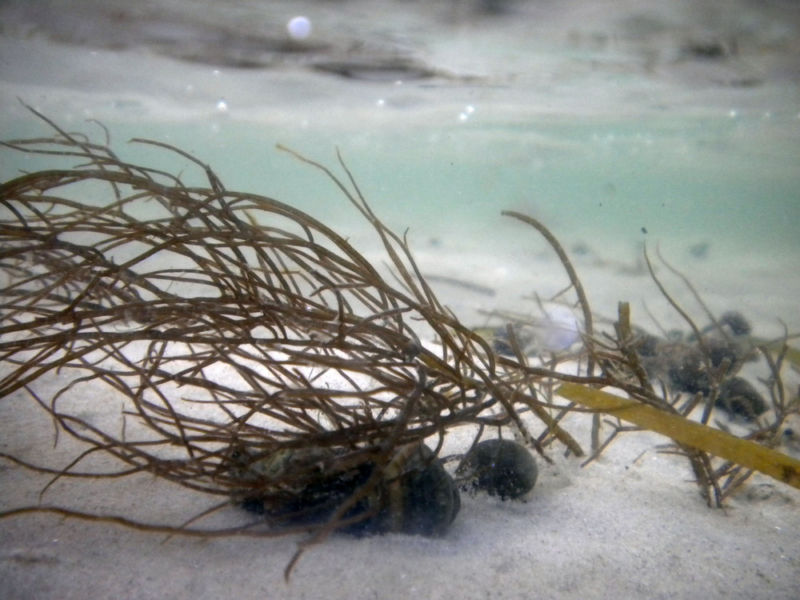
Across the globe, invasive species have caused no end of trouble. Their populations can explode because they have no natural predators. Or they are predators themselves who push native species to the brink of extinction. They can upset ecosystems that had evolved a fine balance.
But, according to a new study published this week in PNAS, not every invasive species is a negative. In some cases where we’ve wiped out a key component of the local ecosystem, an invasive species can take its place. The study’s example? An invasive algae can restore lost habitat to coastal ecosystems, providing a nursery for species like crab and shrimp.
The work that led to this conclusion took place in tidal flats on the coast of North Carolina. Normally, this type of geography is broken up by distinct habitats provided by different organisms: coral reefs, beds of sea grass, and oyster reefs. The habitats formed by these species provide shelter for other species, allowing entire ecosystems to develop. But, over the last century or so, many of these habitats have been wiped out, leaving bare sediment behind.
A helpful invader
In some areas, however, an invasive species of seaweed called Gracilaria vermiculophylla has moved in. Gracilaria forms clumps on what would otherwise be a largely featureless patch of sand and sediment, and it can survive exposure during low tides. The seaweed is not entirely harmless, as it can grow to extreme densities in some habitats, consuming much of the oxygen in water and causing problems for other species.
Along the North Carolina coast, however, Gracilaria seems to be present in low-density populations, with small clumps spread across a wide area. So, an international team of researchers decided to test whether the Gracilaria populations generated any of the ecosystem functions that were provided by species that have since been displaced. To do so, the researchers defined a series of five-meter-by-five-meter plots on what was otherwise a bare patch of coast. These were either left bare as controls or planted with Gracilaria at different densities.
Once a month, the researchers returned to the sites and measured seven different ecosystem functions. Ten months later, they tabulated the results and determined whether the density of Gracilaria influenced any changes that occurred.
Two of the measures—stabilization of the seafloor at the site and changes in the decomposition of material—were unaffected by the seaweed’s presence. But it did slow the flow of water through the area. And the habitat it created attracted more animals and a larger variety of species. Plots with the seaweed present also served as nurseries, with many juveniles present from a number of species, including commercially harvested fish, crabs, and shrimp.
The amount of seaweed required for these effects varied. Any of the algae at all was enough to attract other species, but the area didn’t become a nursery until there was a higher density of Gracilaria around.
When to fight
So, overall, having Gracilaria in this environment appeared to be a good thing. “This invasion has an overall positive, density-dependent impact across a diverse set of ecosystem processes,” the authors conclude. And that, they argue, doesn’t fit with the traditional response to invasive species, which is to get rid of them.
Instead, the authors argue, we should think carefully about alternative approaches. If we’re not going to restore the original habitat, such as a bed of sea grass, then leaving Gracilaria around would be better for the ecosystem as a whole. And, if we are going to kill off Gracilaria and try to restore the native habitat, then we should try to ascertain whether the restoration will work. In some cases, invasive species outcompete the natives. But in others, environmental changes (human driven or otherwise) killed off the natives before Gracilaria even appeared. Unless the earlier conditions can be restored, too, then we’re not going to be able to return to the native habitat.
And, if we’re going to keep Gracilaria around, we probably will want to control its population levels so that it doesn’t lead to overgrowth and oxygen depletion. But the authors found that different population levels are needed for specific ecosystem functions. So any management efforts will have to take that into account.
The clear takeaway is that there is no one-size-fits-all solution to invasive species. Instead, we have to decide what our ultimate goal is and adjust the management strategy to meet that goal. And doing so may involve learning to live with the invaders.
PNAS, 2017. DOI: 10.1073/pnas.1700353114 Â (About DOIs).
